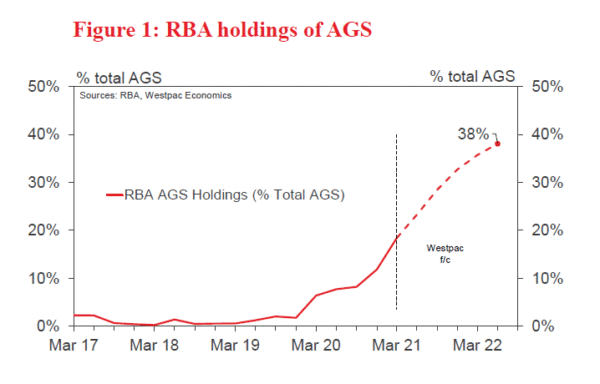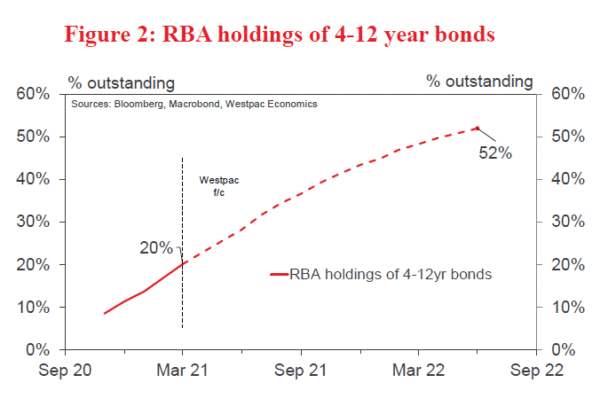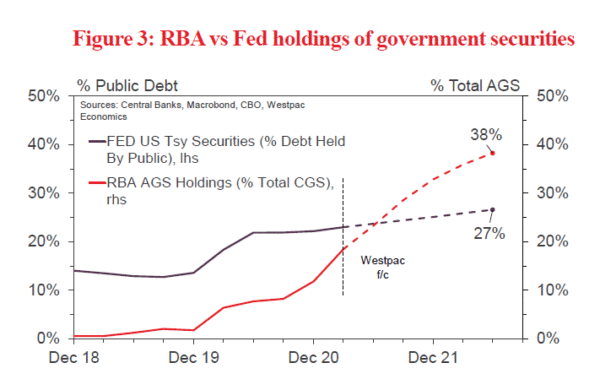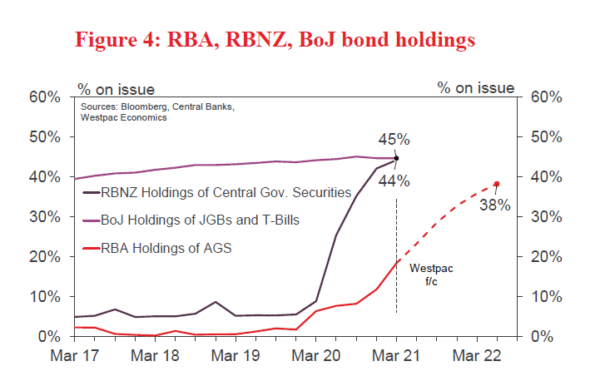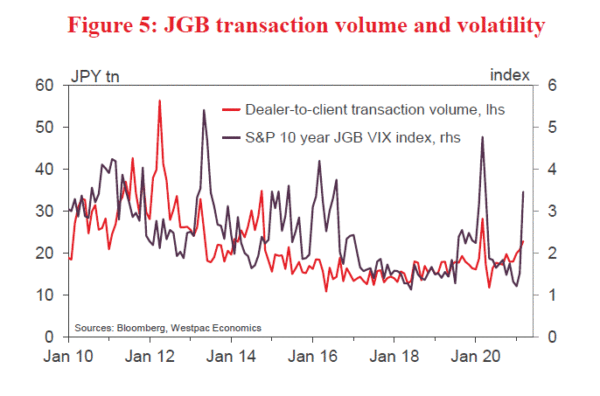We are forecasting that the RBA will extend its Quantitative Easing program (QE) with a third $100 billion program (QE3), which will begin in the first week of September.
That move will complement the decision to extend the Yield Curve Control (YCC) Policy to purchase the November 2024 bond at the cash rate of 0.1%.
We expect both policy extensions to be announced with the Board meeting on August 3.
We see the Bank adopting a clear policy approach of not tightening policy in 2021 with a view to reviewing the policy stance in 2022.
This interpretation is still consistent with the likely decision not to extend the Term Funding Facility (TFF) beyond June. That policy was adopted to assist banks to maintain high levels of liquidity during the uncertain times during the pandemic. With ample liquidity in the system it will be appropriate for the RBA not to extend the TFF.
QE and YCC are aimed at boosting demand and employment through containing upward pressure on the AUD and supporting confidence that the RBA still expects that it will not be raising the cash rate before 2024 “at the earliest”.
Accordingly, at the February Board meeting in 2022, we expect the Board to announce that it will not be extending the YCC policy to cover bonds maturing in 2025 (April 2025 bond and beyond) and it will be tapering its QE program to $50 billion in purchases from early March, when QE3 has expired.
We expect that the $50 billion extension (QE4) will be the final tranche in the program.
In that regard, it is interesting that the Minutes of the April Board meeting noted that by the end of the current program (QE2) the Bank will hold around 30% of Australian Government Securities (AGS) on issue and 15% of semi-government securities. This observation indicates that the Bank is very mindful of its potential to restrain liquidity in the bond market.
In this note we project the RBA’s holdings of AGS by June 2022, near the completion of QE4.
We consider RBA’s holdings of AGS overall; make an estimate of the RBA’s expected share of holdings of longer-term securities; and compare RBA’s position with the Federal Reserve, the Reserve Bank of New Zealand (RBNZ) and the Bank of Japan (BoJ).
The RBA’s Holdings as a share of AGS on Issue by June 2022
Our forecasts are based on the following assumptions with respect to future bond issuance over the remainder of 2020/21 and 2021/2022.
- The FY 2020/21 deficit will be $150bn, roughly $50bn less than the current Mid-Year Economic and Fiscal Outlook (MYEFO) forecast of $197.7bn.
- The FY 2021/22 deficit will be $85bn, which incorporates a $50bn reduction from the MYEFO forecast of $108.5bn, offset by $25bn in new spending and tax cuts.
- The AOFM issuance program will be adjusted for revised Budget estimates.
Figure 1 sets out our estimates of RBA’s share of total AGS on issue.
We therefore estimate that by the end of the QE program, RBA will hold around 40% of total AGS on issue.
RBA’s Holdings of 4-12 year maturities on Issue by June 2022
We now consider the RBA’s ownership of AGS in the 4-12 year maturity range, which corresponds to the securities that the RBA has purchased under QE to date.
Our forecasts are based on the following assumptions.
- 75% of new issuance by the AOFM will be in the 4-12 year maturity range.
- Future QE purchases will continue to be in the 4-12 year maturity range.
Figure 2 sets out our estimates of RBA’s forecast share of holdings of AGS in the 4–12 year range.
We estimate that by end June 2022 RBA will hold around 50% of all AGS in the 4–12 year range.
RBA’s Holdings of AGS compared to other central banks: US Federal Reserve; Bank of Japan; Reserve Bank of New Zealand.
The FED forecasts are based on future debt and deficit estimates from the CBO and the assumption that the FED will continue to purchase $80 billion in Treasuries per month out to June 2022.
Figure 3 compares our RBA estimates with the FED.
RBA will be cognizant of QE distortions seen in other sovereign bond markets
The RBA’s ownership of the bond supply will run well ahead of the FED by June 2022.
By this point, RBA ownership will more closely resemble the RBNZ (which currently owns 44% of central government securities) and the Bank of Japan (currently owning 45% of JGBs and T-bills). See Figure 4.
In Japan, there are signs that the BoJ’s asset purchase program has distorted the government bond market.
As shown in Figure 5, dealer-to-client transaction volumes have fallen roughly 33% compared to the average over 2012 (the year before the BoJ launched its Quantitative and Qualitative Monetary Easing (QQE) program), and the volatility of the 10 year bond has steadily reduced over the same period. Moreover, widening bidask spreads point to some “crowding out” of private investors.
In New Zealand, the Assistant Governor of the RBNZ has previously stated that the percentage of the bond market that could be purchased without creating distortions would be “in the order of 40 to 50% of individual issues”.
Compared to its international counterparts, the AGS market may also be more vulnerable to distortions from central bank purchases.
Firstly, around 52% of the ACGB market is owned by non-residents. Many of these investors (e.g. central banks, pension funds) buy and hold sovereign debt and are less likely to contribute to liquidity by selling back into the secondary market. This compares to 13% foreign ownership in Japan and 30% in New Zealand.
Of the remaining 48% of ACGBs owned by residents, roughly half are held by Authorised Deposit Taking Institutions (ADIs). ADIs are required to hold sovereign bonds to meet regulatory requirements, so net sales from this pool of investors will be restricted.
Conclusion
We think RBA will assess that it will have reached a comfortable limit in terms of its share of holdings of AGS by July 2022 when QE4 expires.
RBA has emphasised in the past that it is committed to the orderly function of the Australian bond market.
While the Federal Government is likely to delay Budget Repair for a number of years, annual deficits will still be falling.
Maintaining a QE program beyond our forecast QE4 is likely to see the RBA crowding out the bond market; risking disruption to its functioning; and constraining liquidity which could perversely precipitate a widening of bond spreads as investors claim a liquidity premium to hold Australian bonds.




